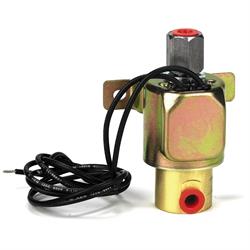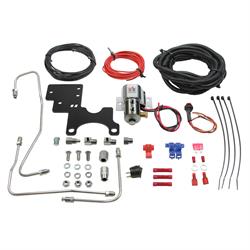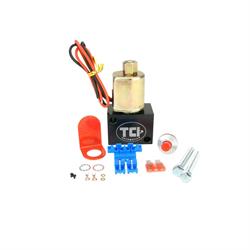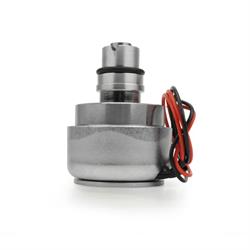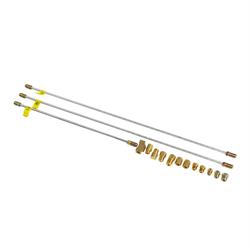How Does a Line Lock Work | How to Do an EPIC Burnout
You’ve seen the spectacle, heard the thunder, and probably even caught a whiff of that sweet, smokey scent of burning rubber. There’s nothing quite like the perfect burnout! But laying one down isn’t just about hammering the throttle and hoping for the best. It takes some skill and the right gear.
That’s where a line lock comes in. This simple device is the key to executing a safe, controlled burnout. What does a line lock do? We’re glad you asked! Let’s dig into what line locks are, how line locks work, how to install them, use them, where to let them loose, and how they stack up against another helpful tool for the drag strip.
What is A Line Lock and How Does a Line Lock Work?
In simple terms, a line lock is an electronically controlled solenoid valve that’s wired into your front brake lines. Once you activate it, the system holds brake pressure at the front wheels while releasing it from the rear brakes. This keeps the front brakes engaged–and the car in one place–while letting the back wheels spin freely.
Line locks are a tool of the trade in drag racing, where burnouts heat up the rear tires for better grip off the line. Without one, you’d be stuck having to carefully balance the brake and throttle to keep the car from drifting forward. But with a line lock, all you really must do is press the brake pedal, engage the system, and hit the throttle.
Beyond burnouts, line locks can also be used for more precise staging. They give you better control at the starting line without having to ride the brake pedal or use the parking brake to keep the car stationary.
How to Operate a Line Lock
Using a line lock is straightforward once you get a handle on the sequence. Let’s break it down step by step:
- 1. Get the car into position. This usually means rolling into the burnout box (or another safe, open area) and straightening the wheels. If you’re at the drag strip, make sure your rear tires are centered on the track surface.
- 2. Mash the brakes. This applies hydraulic pressure evenly to all four brakes and effectively locks the wheels.
- 3. Engage the line lock. While keeping the brake pedal pressed down, engage the switch to your line lock. You may hear a click as the solenoid locks pressure going to the front brakes.
- 4. Release the brake pedal. Gradually take your left foot off the brake pedal. The front brakes should stay engaged, but the rears are now free.
- 5. Light ’em up. With your right foot, roll into the throttle. Power will make its way to the rear wheels, which gets the tires spinning and, ideally, starts producing a sweet smokey burnout.
- 6. Shut it down. Once you’ve completed your static burnout, release the line lock button/switch, returning the vehicle to standard brake operation. Let off the throttle and press the brake pedal to slow/stop the car. You are now ready to slowly move forward and stage the car for your drag race.
Line Lock Diagram and Installation Tips
Installing a line lock does take some basic mechanical know-how and familiarity with your car’s brake system. In a typical setup, as you can see in the accompanying diagram, the device is plumbed into the front brake hydraulic circuit, with the solenoid valve positioned between the master cylinder and front calipers. When the switch is turned on, the solenoid traps the brake fluid in the front lines, which keeps the brakes engaged even after you release pressure on the brake pedal.
When it comes to installation, make sure you’re using the right fittings, and that all your hydraulic connections are tight and free of leaks. That means using proper brake flares, double-checking your torque specs, and mounting the solenoid in a safe spot, where it won’t interfere with other parts or get exposed to too much heat. Be careful with your wiring, too. The solenoid will need a 12V power source, and an activation switch that’s easy to reach from the driver’s seat–think shifter, steering wheel, or dashboard.
Once everything’s in place, bleed the brakes to get rid of any air bubbles; a spongy pedal is the last thing you need. And always refer to the manufacturer’s instructions and check out our full line lock install guide for Hurst Roll Control systems.
Is A Line Lock Street Legal?
In most cases, having a line lock brake holding device on your car is perfectly legal. It’s not disabling or bypassing the braking system; you’re just adding another level of control to the front brakes. So, there’s no issue with it being there. That said, if you get caught doing donuts in a parking lot, roasting the tires at a stoplight, or otherwise putting on a show in public, you could get cited for careless or reckless driving, or even have your car impounded. In other words, using a line lock anywhere other than a closed course or the track could land you in hot water, and nobody wants that.
Interestingly enough, a handful of modern muscle cars now come with factory-installed line lock systems. The Ford Mustang GT, Chevrolet Camaro SS, and Dodge Challenger SRT all have built-in burnout modes that work a lot like aftermarket setups. But even those systems come with warnings that they're for track use only. Bottom line: If you're going to have fun with your line lock, be smart about where you do it.
Is A Line Lock for Burnouts?
Yes, line locks are mostly used for controlled burnouts. In drag racing, where hundredths of a second matter, a good launch can mean the difference between victory and defeat. Tires grip better when they’re warmed up, and burnouts help them reach their ideal temperatures for better traction and a harder launch off the starting line. Line locks make those burnouts safer and easier.
There are two main types of burnouts: stationery and rolling. In a stationary burnout, the car stays put while the rear tires spin, building up heat and smoke. This is the most common type, and what you’ll usually see–or do–in the burnout box at the drag strip. You engage the line lock to hold the front brakes, hit the throttle, and send the rear wheels spinning.
A rolling burnout is a little trickier. How it’s done and the difficulty level will vary depending on the type of car (manual or automatic, RWD or FWD, etc.) and how much power you’re working with. Either way, you’ll want to start by disabling the traction control and stability control systems, then getting the car moving at around 10 mph.
If you’re driving a manual, depress the clutch and rev the engine to about 3,000-4,000 rpm. Then, dump the clutch while flooring the throttle. Keep the steering wheel straight and modulate the throttle to control the burnout. To stop spinning the tires, lift off the throttle or depress the clutch.
In an automatic, you’ll use moderate brake pressure with your left foot, put the car into Drive, and apply throttle with your right. Once the rear tires start spinning, you can balance the brake and throttle pressure to control your burnout. Note: It takes a little more skill to nail a rolling burnout, so you’ll probably need some practice to get the timing down.
What’s the Difference Between a Line Lock and Transbrake?
Although line locks and transbrakes are both used in drag racing, they’re two completely different components that work in separate ways and serve different purposes. We know that a line lock is part of the braking system. It holds the front brakes while letting the rear wheels spin away for burnouts and staging.
A transbrake, on the other hand, is used only with automatics. It locks the transmission by engaging both Drive and Reverse at the same time, holding the car in place while you rev the engine and build up torque. Then, when you release the transbrake solenoid, reverse gear disengages and the car blasts forward with all that stored-up power. It’s not unusual for drag racers to use both; a line lock for burnouts, and a transbrake for launch. But if you’re just looking to smoke the tires, a line lock is all you need.
Unleashing the Perfect Burnout with a Line Lock
Whether you’re heating up the tires for a precise launch at the line or just want to light up your ride with an eye-catching smoke show, a line lock is your ticket to the perfect burnout.
Just remember that while these devices are simple enough to install–and work like a charm once you dial in the sequence, they should only be deployed at the race track or in a safe, controlled area away from anything that could spoil a good time.

